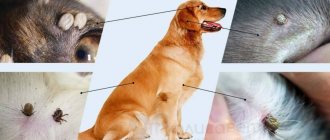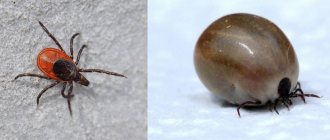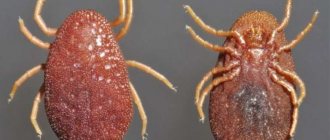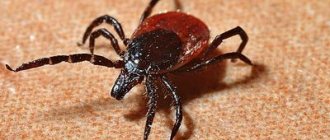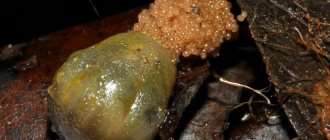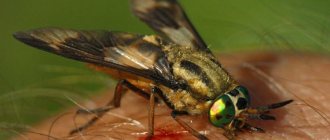The dog was bitten by ticks
Spring, veterinarians warn, is the beginning of the season for the incidence of piroplasmosis, a deadly disease for dogs transmitted by ixodid ticks.
Currently, the disease is recorded throughout almost the entire territory of Russia, where its main carriers are ticks. The territory of Moscow and the Moscow region is also unsafe for piroplasmosis.
Pet owners should take care of prevention, be aware of the signs of disease and first aid measures in case of a tick bite.
Types of ticks
Ticks that parasitize dogs are divided into 2 groups:
- External
- Subcutaneous
Next we will take a closer look at each of these types.
External
In turn, external mites are divided into groups:
Ear mites
Mites in the ear
This mite causes ear scabies, a very common and contagious disease in animals. They are localized mainly on the inside of the ear, less often they migrate to the animal’s head. Ear mites live for two months, outside the animal’s body for up to two weeks.
Ixodid ticks
What does an ixodid tick look like?
Tick fed on blood
They are forest ones. This is the most common species (we will talk about them in more detail) that lives in forests, parks, trees and bushes. Such ticks are dangerous because the animal does not feel the bite due to the secretion secreted by the tick. If the tick is infected, then transmission of the disease is inevitable.
Heyletiella
Cheyletiellosis in a dog
The causative agents are ticks of the species Cheyletiella yasguri, oval in shape and about 0.38 mm in size. They cause diseases such as: cheyletiosis (Cheyletiosis, Cheyletiellosis, Cheiletiosis) or “stray dandruff”. A person who comes into contact with an infected animal can also become infected, since these diseases are transmitted by contact. Localization of parasites occurs in the upper layer of the skin.
The main symptom is severe flaking of the skin, similar to dandruff. This disease occurs in all breeds of dogs and looks like moving pieces of skin.
Argasid mites
Argas mite
Such ticks attack in large groups and cause exhaustion in animals. They are similar to ixodid ticks, but live in drier and hotter places, as well as in enclosed spaces. The bites are very painful; infection occurs not only through the bite, but also through the secretions of these ticks. They are carriers of borreliosis and encephalitis. Without a host, argas mites can live up to 14 years.
Subcutaneous mites
Subcutaneous mites are further divided into several types:
Sarcoptoides
Sarcoptic mange
Itching mites of the genus Sarcoptes, which cause sarcoptic mange and feed on lymph and dead skin particles. They settle on the muzzle, head, tips of the ears and in the elbow bends. Infection occurs through contact or through care items.
Symptoms: itching, the dog is very itchy, small spots on the body, pus and ulcers may appear.
Demodectic
Dog with subcutaneous mites (Demodectic mange)
Or "hairy". The causative agent is the Demodex mite. They live in hair follicles throughout the dog's life. According to veterinarians, the presence of demodicosis is normal for domestic dogs.
Scabies (Notoedrosis)
Notoedrosis
The culprits are scabies mites of the genus Notoedris cati. They multiply inside the epidermis and cause a disease - notoedrosis, accompanied by skin inflammation and severe itching. At the beginning of the disease, they settle on the animal’s head, then spread to other parts of the body. Possible death if the disease is neglected.
Symptoms: blisters (papules) that become crusty, bald spots due to scratching.
Diseases caused by ixodid ticks
Let's take a closer look at the diseases that occur after an ixodid tick bite:
- Hepatozoonosis. With this disease, leukocytes are damaged, fever begins, joint pain appears, the eyes become inflamed, and weakness is observed.
- Ehrlichiosis. The disease develops in white blood cells and is accompanied by debilitating fever.
- Borreliosis. Develops inside the womb and leads to the death of the offspring. Arthritis and neurological abnormalities are observed.
- Piroplasmosis. The most common disease in dogs after a tick bite in the Russian Federation. We will talk about it in more detail.
When should you contact a veterinarian and what will he do?
You should contact your veterinarian if you suspect a tick bite. The fact is that even a successfully removed tick could be a carrier of infection.
Important information!
Save the tick so you can give it for analysis and not worry about the health of your four-legged friend.
Also reasons to contact a veterinarian are:
- The dog is very restless.
- Active hair loss.
- Redness of the skin.
- Complete refusal of food.
- Signs of pain (whining, howling, the dog tries to hide, bury its head, etc.).
If these signs persist for more than a day, then you need to show the dog to a doctor and get tested. The veterinarian will be able to correctly diagnose and select treatment to eliminate the pathogen and alleviate the symptoms of the disease.
What is piroplasmosis (babesiosis)?
The causative agents of piroplasmosis are single-celled piroplasma parasites (Piroplasma canis or Babesia canis), which enter the body through a tick bite. The parasite is transmitted by ixodid ticks of the genera Dermacentor and Rhipicephalus. In the international classification, the disease is called babesiosis.
Pyroplasmas are found in the salivary glands of the tick and when bitten, along with saliva, enter the blood of dogs. In this case, the destruction of red blood cells occurs, a large volume of hemoglobin is released, this leads to the fact that the internal organs of the animal cannot cope with such a load.
The consequences of all this are the release of toxic substances (decomposition products), as a result of which organs such as the spleen, liver, and kidneys suffer. The most serious consequence is hypoxia of the animal’s brain (oxygen starvation).
Mite of the genus Dermacentor
Tick of the genus Rhipicephalus
Although babesiosis has been well studied and highly effective treatments are available, it is often fatal, usually because the animal is brought to the veterinarian too late.
The longer piroplasmosis lasts, the more severe the consequences for the body.
The disease has a pronounced seasonal peak character: the warm season (spring-summer). Peaks of incidence occur in May-June and August-September. However, the disease can occur from April to the end of October.
Typically, ticks attack dogs while walking in areas overgrown with bushes or tall grass.
Newly attached, it is no larger than the head of a pin; Once pumped with blood, it can reach the size of a large bean.
Where do ticks come from on dogs?
Diseases and symptoms
Piroplasmosis (babesiosis) is one of the most dangerous diseases for dogs. The tick infects the animal with intracellular parasites Babesia, which penetrate the blood and infect red blood cells. The disease has the most severe effect on the liver and kidneys.
Symptoms: fever, thirst, rapid pulse and breathing, refusal to eat, vomiting, lethargy, dark urine.
Borreliosis (Lyme disease) is quite common in Russia and is transmitted by several species of ixodid ticks. The disease is characterized by the fact that it has a long asymptomatic (latent) period - from 2 to 6 months, and can also become chronic, which lasts more than six months. The success of treatment largely depends on the time of initiation of active therapy. The course of the disease depends on the individual characteristics of the organism.
Symptoms: weakness, fever, changes in gait, muscle pain, joint damage and many others.
Anaplasmosis is a pathogen that attacks blood cells. The first symptoms of the disease may appear after 1-2 weeks or after several months. Anaplasmosis can also be long-term, chronic. This disease can only be prevented with the help of antiparasitic drugs.
Symptoms: lack of appetite, lethargy, enlarged lymph nodes, fever, bruises, dark urine, weight loss, nosebleeds.
What to do if your dog is bitten by a tick?
If you find that a tick has bitten your dog, you need to provide him with help. The main thing is not to panic! You can remove a tick without any problems at home. Carefully remove the tick, place it in a glass jar and take it to the clinic.
How to properly remove a tick?
Advice from veterinarians at the Univet clinic:
Be sure to carefully inspect your dog after each walk for ticks, and comb the fur thoroughly. If you notice a tick attached to a dog, under no circumstances try to pull it out immediately , as this only removes the body, while the head remains and causes inflammation.
To remove, you can use special products, or drop some oil, alcohol, or gasoline. After a few minutes, it will either fall off on its own or loosen its grip, and then it can be pulled out (preferably using a special tool or tweezers).
You can also pull out the insect using a thread, wrapping it around the parasite's proboscis and pulling the ends of the thread to the sides, twisting it upward. This procedure must be carried out slowly and carefully.
After removing the tick, it is advisable to wash the pet and treat the wound with a 5% iodine solution.
Not every dog will become infected if bitten by a dog tick. But, unfortunately, the tick does not indicate whether they can infect or not.
This means that now your main task is to carefully monitor your pet’s health and measure its temperature several times a day. The incubation period lasts 6 - 10 days.
Also, if you pulled out a tick at home, then it should be taken for laboratory examination to find out whether the parasite was a carrier of piroplasmosis.
The course of the disease is most often acute, but it can be chronic, as well as hyperacute, when animals die in a matter of days. Therefore, when the first symptoms are detected, you should immediately contact a veterinarian to confirm the diagnosis and begin treatment.
Tick removal process
Symptoms of piroplasmosis
Symptoms and signs of piroplasmosis are:
- Temperature rises to 40 - 42°C. Normally it should be 37.5 - 39°C, for small breeds up to 39.5.
- Yellowing of the whites of the eyes or visible mucous membranes
- Urine becomes reddish (blood)
- Possible infection is also indicated by apathy, weakness and refusal to feed.
- Breathing and heart rate increase
These are nonspecific symptoms after tick bites, common to many diseases.
If your dog has these symptoms, you must immediately show it to a veterinarian!
How do ticks attack and why are they dangerous?
The parasite itself does not pose a serious threat: although the tick feeds on blood, it will not be able to seriously bleed the animal. The main danger is the diseases it can carry. Not all ticks are carriers of diseases, but this can only be determined for sure through laboratory testing.
The tick falls on the victim from low vegetation (grass and bushes). It does not immediately bite into the victim; it takes some time to get to a suitable place on the animal’s body. As a rule, parasites choose places with thin skin, a small amount of hair and close proximity of blood vessels (head, ears, paws).
It is extremely difficult to understand that a dog has been bitten by a tick before it is detected. Digging into the skin, it releases a special substance that seems to numb the bite site. The first symptoms of illness (changes in behavior, refusal to eat, fever) may not appear immediately. The time for the first signs of the disease to appear varies from 2-14 days to several months and depends on the causative agent of the infection that the tick transmitted to the dog. By the time the first symptoms of the disease appear, the dog’s body may be seriously weakened. In this case, qualified assistance from a veterinarian is required, who will prescribe special treatment.
Diagnostics
The diagnosis is piroplasmosis, made on the basis of clinical signs, anamnesis (detection of attached pests on the dog’s skin), and epizootological data. The results of microscopy of blood smears are decisive. But, since the parasite is not present in erythrocytes at all stages of the disease, the absence of piroplasms in the smear does not exclude piroplasmosis.
In such cases, when making a diagnosis, they rely on the course of the animal’s illness, medical history and the results of other laboratory tests (urinalysis, biochemistry, general blood test).
Treatment
Treatment for bites is carried out in two directions:
Destruction of the causative agent of piroplasmosis
To destroy the causative agent of the disease, drugs from the group of organic dyes, diamidine derivatives, are used: Berenil, Azidine, Veriben, Batrizin . The active ingredient of these drugs is diminazene aceturate.
Imidocarb derivatives are also used: Piro-Stop, Forticarb, Imidosan.
The drugs are administered intramuscularly; a common property of the active substances is their high toxicity not only to the pathogen, but also to the patient. Since these drugs do not have a preventive effect, they are used only after a diagnosis has been established, under the supervision of a veterinarian!
Removing intoxication and maintaining the general condition of the animal’s body
To relieve intoxication and maintain the body, a large number of medications are used:
- Saline solutions (Ringer's solution, Sodium chloride, Glucose 5%)
- Vitamin complexes (Gamavit, Vitam, Ribotan, Butastim, Azoxyvet, Catozal, Vetozal)
- Heart medications (Sulphocamphocaine, Riboxin, Cordiamin, Camphor, Lauritin S)
- Inflammation-reducing agents (Dexamethasone, Prednisolone)
- Maintaining liver function (Essentiale forte, Legalon, Silibor, Karsil, Coverta
The volume and duration of treatment depends on the patient's condition. In any case, the recovery period lasts at least one month and requires follow-up tests.
Prevention memo
Prevention of tick attacks on dogs and the diseases they carry is as follows:
- Destruction of the parasite in the natural environment. You cannot eliminate ticks in forests and parks at your discretion, but you have the right to carry out decontamination in your personal garden or summer cottage. The drug Medilis-Ziper ensures the destruction of parasites and protection against the appearance of new ones for 1-1.5 months. 12 ml of concentrate is consumed per hundred square meters. The cost of 0.5 liters of pesticide is 1200 rubles. In addition to the above, the following acaricidal agents are in demand: Argus Garden;
- Dobrokhim FOS;
- Dr. Klaus;
- Ram.
If you have any questions, I will answer in the comments.
Next: Large dog breeds with photos and names
Prevention. drugs and protective equipment
Drops on the withers
Prevention of piroplasmosis consists in preventing an attack on the animal; for this, they are treated with acaricidal drugs, which are available in the form of:
| Flea and tick remedies. Prices. | ||
| Collars | “Foresto”, “Kiltix”, “Bolfo”, “Hartz”, “Beaphar”. | The cost of collars is from 200 RUB to 2000 RUB. Depending on the size of the dog and the function of the collar |
| Sprays | “Frontline”, “Bolfo”, “Defendog”, “Bars”. | Spray prices from 250 RUB to 1500 RUB |
| Drops on the withers | "Advantix", "Frontline", "Hartz", "Bars", "Serco", "Stronghold". | The price of drops is from 120 RUB to 1500 RUB. Depending on manufacturer and volume |
| Pills | "Bravetko", "Frontline", "Zoetis", "Nexgard Spectra" | The cost of tablets is from 400 RUB to 2000 RUB |
These products are distributed over the skin and hair without being absorbed into the blood. Upon contact with treated hair and skin, it dies. These products, unfortunately, do not provide 100% protection against parasites; the effectiveness of these drugs depends on how much time has passed since their application. Protective equipment must be used in advance (2-3 days before going out into nature or going on vacation).
When purchasing protective equipment in veterinary pharmacies or pet stores, be sure to pay attention to the expiration date, integrity of the packaging, and instructions in Russian. Be sure to read the instructions!
It must be remembered that:
- When using anti-mite drugs, contact allergies are possible.
- When using the spray, it is necessary to treat not only the animal’s body, but also the paws and head, and especially carefully the groin area, armpits and behind the ears.
- If the dog has long hair, then the spray consumption increases up to 2 times.
- If your dog bathes frequently (or you wash it), then the frequency of anti-tick treatments needs to be increased.
- The packing of drops at the withers must strictly correspond to the weight of your pet.
Very often, owners turn to the veterinary clinic with a request to get vaccinated against piroplasmosis. Currently, in order to form an immune response in dogs to the causative agent of babesiosis, the Pirodog Vaccine is used.
Vaccine Pirodog
Folk remedies for ticks
How else can you protect your dog from ticks?
Below are traditional methods for fighting ticks for animals:
- Vanilla tincture. Mix 100 ml of vodka with 7 g of vanilla and leave for 7 days. Apply to the withers, belly and llamas immediately before a walk.
- Fragrant (scented) collar. 15-20 essential oil, which is effective against ticks, is applied to the animal’s collar. Used exclusively for walking.
- "Perfume" with the aroma of wormwood. In this recipe you can use dry wormwood (20 g) or fresh (50 g). Mix the wormwood with 400 ml of water and boil. Cool and pour into a spray bottle. We use such perfumes when necessary. When walking for a long time, apply perfume every 2-3 hours.
IMPORTANT! Monitor the animal's reaction to a particular essential oil.
Even though you take precautions, keep a close eye on your dog and check it regularly. If signs of illness occur, contact your veterinarian.
Remember, self-medication can cause irreparable harm to the health and life of your pet!
If you find similar symptoms in your dog, do not experiment! It is necessary to urgently contact a veterinary clinic; if for some reason this is not possible, use the service of calling a veterinarian at home.
Have you ever encountered ticks? Leave your questions for the veterinarian in the comments.
Consequences
Ticks become active during the first spring warmings. In the south of Russia this is the end of February, in the middle zone and in the north - April-May. In the heat, the parasites lose activity, but with the first autumn rains they resume.
Ixodid tick
How dangerous is a tick bite for a dog?
Eggs require animal protein to mature. Ixodid ticks have adapted to obtain it from the blood of mammals. The parasites attach themselves to the animal’s skin and secrete painkillers so that the dog does not notice the presence of guests. To prevent blood clotting, the parasite secretes anticoagulants.
How long does a tick live on a dog? The parasite needs time to choose a secluded place, attach to the skin, make a puncture and suck on. Most often, the tick is attached to the folds of the skin or ears. The female is saturated with blood for 6 days and increases in size a hundred times. In total, the parasite can live on a pet for up to 10 days.
If a dog has a lot of ticks attached to it, anemia develops. The pet weakens, becomes defenseless against the permanent inhabitants of the skin - coccus bacteria, and develops dermatitis and abscesses. The main danger to animals and humans are sexually mature individuals, mainly females, who carry pathogens.
Ixodid ticks prefer secluded places
It is dangerous for the parasite to get inside. If a dog accidentally swallows a tick, it will dissolve and pathogens will enter the bloodstream.
What diseases can ticks transmit to dogs?
The following infectious diseases pose the greatest danger:
- Piroplasmosis (babesiosis). Caused by protozoan microorganisms that settle inside red blood cells.
- Bartonellosis is caused by motile bacteria that parasitize red blood cells.
- Borreliosis or Lyme disease is caused by spirochetes.
- Ehrlichiosis is caused by protozoan microorganisms.
Ixodid ticks are dangerous not only for dogs. In the steppe regions, through the bites of arthropods, people become infected with Crimean fever, and residents of the taiga become infected with tick-borne encephalitis.
Can a dog die?
If you find a tick on your dog, don't panic. Not every parasite is infected. In addition, the arthropod needs time for protozoan microbes or pathogenic bacteria to move from the intestines to the salivary glands.
However, if you missed the moment of tick attachment and find it already sucking blood, consult a doctor.
If the arthropod is infected with Babesia, the dog may die.
When infected with other pathogens, recovery is possible, but death cannot be ruled out after a long illness.
The tick sucked blood
Read also
Subcutaneous mites in dogs: treating demodicosis
What disease can lead to serious consequences for a dog’s body or even death? The most common and dangerous disease is demodicosis.
Ear mites in dogs: Symptoms and treatment of otodectosis
Otodectosis or ear scabies is a chronic invasive disease caused by microscopic itch mites.
Dog castration: 5 reasons for and against
Castration is one of the most responsible ways to care for a dog. With the help of the procedure you will reduce aggression and anxiety associated with testosterone
What diseases are most common in dogs? Symptoms and signs
A dog cannot complain; it is necessary to determine that it is sick by the appearance and behavior of the pet
Fleas on a dog. How to withdraw?
Fleas can cause a lot of discomfort and suffering to your animals, but they must be removed very carefully
The danger of tick-borne infections for humans and dogs
Ticks are not harmless parasites. They are capable of transmitting a lot of infections. Tick-borne encephalitis is more dangerous than the others. Against the background of the virus, the dog develops fever, headache, muscle pain, disturbances of consciousness and even paralysis.
Also dangerous is borreliosis, a disease accompanied by severe intoxication and heart problems, as well as an acute allergic reaction at the site of the bite.
Another dangerous complication for humans and dogs is piroplasmosis. The disease provokes the destruction of red blood cells with a pronounced clinical picture:
- thirst;
- lack of appetite;
- stomach upset;
- rise in temperature;
- dyspnea;
- yellowing of mucous membranes.
Ticks can carry tularemia, Q fever, typhus and relapsing fever, and you can die from each of these diseases. Therefore, you should not underestimate the danger of a tick bite, and it is always better to be on the safe side by getting tested.
All the diseases described and their consequences are relevant for both dogs and humans. Therefore, the owner of the animal must be careful when communicating with his pet. If you are inspecting fur and skin for the presence of parasites, it is better to do it with gloves. You need to lay down an oilcloth in advance so that the parasites fall on it, they can be seen and can be caught.
But don't be afraid right away. Ticks have now become very active - they appear after the first frost and go away only when snow falls in winter, but this is not a reason not to walk the dog or do it in a protective suit. Ordinary care and care of the animal will avoid serious consequences.

